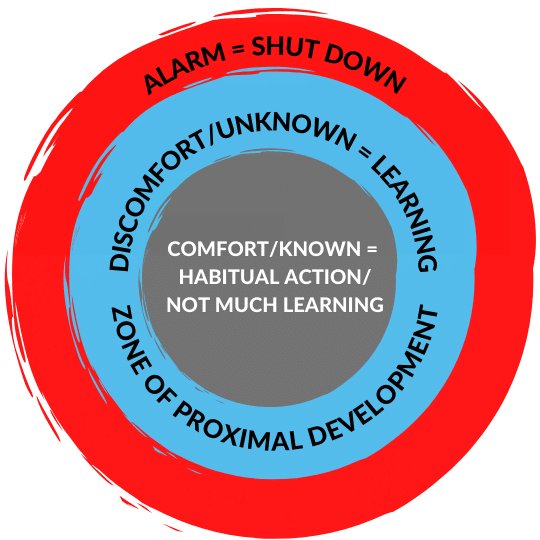If you try this activity with your student(s), we’d love to see what you do. Share your journey via the #Inspired2Learn hashtag on your preferred social platform.
Created by: Aleta Margolis
Discipline: With some language modification this activity can be applied in any subject and for any grade level.
Age level: Elementary through High School
Time: 15-20 minutes for the activity and a debrief
Materials: Zone of Proximal Development graphic, space large enough for students to move freely, chalk for drawing circles if you are outside
Most of us are familiar with psychologist Lev Vygotsky and his construct, the zone of proximal development. In simple terms, challenging students to spend time in their zones of proximal development means helping them identify their capabilities and competencies, and then stepping just far enough outside of their comfort zones to stretch toward what might be possible. This is a simple exercise to do with your students in the first days of school to help them understand this concept.
What to do:
Clear a space in your classroom, or better yet, head outside to the playground or any open space. Share this image (if you’re outside, you can simply show it to students; if you’re inside, you can post it on the wall).

Gather everyone together in the center of the space, pointing out that you are now in the “comfort zone.” Invite your students to imagine the three concentric circles in the graphic. Let them know you will call out a series of activities. For each prompt, each person should move to stand in the “comfort zone” or “unknown” or “alarm zone” depending on how they feel about the activity. Here is a sample list to get you started:
- Meeting someone for the first time
- Going on a rollercoaster
- Giving a speech
- Playing team sports
- Dancing
- Cooking
- Walking a dog
- Carrying a spider outside
- Reading
- Eating a new food
- Trying to talk to someone in a language other than English
- Trying to solve a math problem I’ve never seen before
- Add your own items here!
Adjust the list however you like, noting that it’s wise to begin with general items, and then move into prompts that are specific to your classroom.
After a while, invite students to shout out their own prompts for everyone to respond to. Be sure to play along with your students, so they can learn about your comfort zones too.
End the exercise by inviting students to share their observations, how they felt while playing, and what they noticed about themselves and others. You might also ask how they think this activity might connect to the learning experience they’ll have in school this year, and see where that conversation goes.

I recommend this exercise at the beginning of the school year to show students that their classroom is a place where they will be supported and challenged at the same time. It helps set up a learning environment in which students know they will be expected to push themselves and work hard, and that they will be safe and supported when they step outside of their comfort zones.
Inspired Teaching Connection:
An activity like this both establishes and builds upon Mutual Respect in the classroom. It’s particularly important for you as the teacher to participate so your students see you as a learner just like they are. This activity also offers an opportunity to talk with students about Wide-ranging Evidence of Student Learning and the fact that even if we’re not highly skilled at something we’re learning for the first time, showing our effort and growth is evidence that we’re learning. This activity highlights and celebrates the Intellect, Inquiry, Imagination, and Integrity all your learners will be bringing to the classroom this year.
See our instructional model here.
Standards Addressed by this Activity
Common Core College and Career Readiness Anchor Standards for Speaking and Listening
Comprehension and Collaboration:
CCSS.ELA-LITERACY.CCRA.SL.1 Prepare for and participate effectively in a range of conversations and collaborations with diverse partners, building on others’ ideas and expressing their own clearly and persuasively.
Collaborative for Academic, Social, and Emotional Learning Competencies
Self-Awareness: The abilities to understand one’s own emotions, thoughts, and values and how they influence behavior across contexts. This includes capacities to recognize one’s strengths and limitations with a well-grounded sense of confidence and purpose.
Self-management: The abilities to manage one’s emotions, thoughts, and behaviors effectively in different situations and to achieve goals and aspirations. This includes the capacities to delay gratification, manage stress, and feel motivation and agency to accomplish personal and collective goals.
Social awareness: The abilities to understand the perspectives of and empathize with others, including those from diverse backgrounds, cultures, and contexts. This includes the capacities to feel compassion for others, understand broader historical and social norms for behavior in different settings, and recognize family, school, and community resources and supports.
Responsible decision-making: The abilities to make caring and constructive choices about personal behavior and social interactions across diverse situations. This includes the capacities to consider ethical standards and safety concerns, and to evaluate the benefits and consequences of various actions for personal, social, and collective well-being.
Relationship skills: The abilities to establish and maintain healthy and supportive relationships and to effectively navigate settings with diverse individuals and groups. This includes the capacities to communicate clearly, listen actively, cooperate, work collaboratively to problem solve and negotiate conflict constructively, navigate settings with differing social and cultural demands and opportunities, provide leadership, and seek or offer help when needed.
